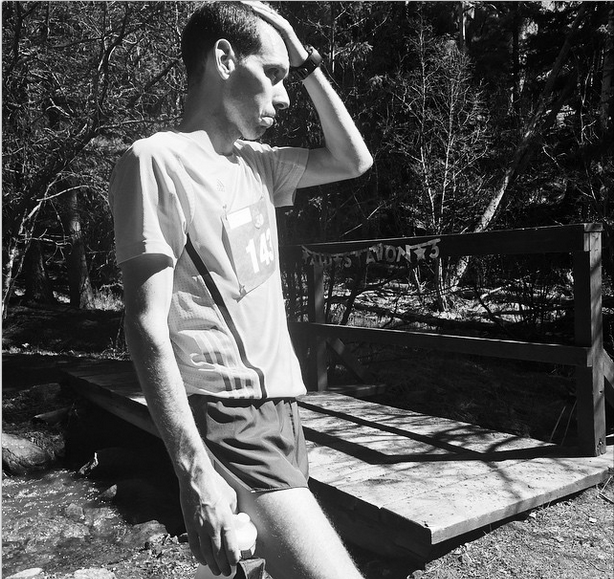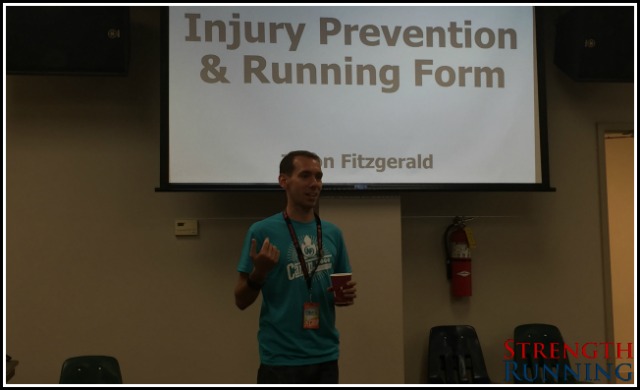Have you ever been ready to quit on your training? Maybe it’s because you just got busy, every run felt terrible, or you saw virtually no progress.

I know the feeling – the same thing has happened to me countless times. Most recently, it was before the 2011 Philadelphia Marathon.
First, my right hip flexor was tight for weeks. I had to cut my precious long runs in distance and speed.
Then, I under-fueled and was unable to hit marathon pace on two key workouts.
I felt exhausted during most of my runs. My workouts were mediocre. The marathon-specific long runs I was running were “ok” – but they felt so hard!
As you can imagine, I was discouraged. Every ounce of effort was poured into training for this race. Philly was my comeback marathon after a poor debut and debilitating injury afterward that left me unable to run for six months.
Everything changed one Saturday morning. I ran a challenging long run: 22 miles with 3 x 3-miles during the second half. Check out these 3-mile splits:
- 18:48 (current marathon pace)
- 18:05 (goal marathon pace)
- 17:46 (sub-marathon pace)
After this run, I started to believe I was ready. But at the time, I didn’t really know if I was ready to accomplish my goal of running under 2:40.
So I got help. I asked another coach about this workout, my goals, and about my chances for cracking 2:40.
Surprisingly, he was convinced. He assured me that if I was capable of running that workout, I could run a personal best in the marathon.
Three weeks later, I crossed the finish line of the Philadelphia Marathon in 2:39:32.
As soon as I finished, I looked over at my wife, smiled, and said “I did it.” She smiled back at me. It was – and still is – the proudest moment of my running career.
But why did I almost drop out before I even started? What was going on that made me nearly DNS?
The Pitfalls of Training Plans
The answer, believe it or not, is that I tried to follow a training plan. And I simply couldn’t do it.
I wrote my own program before Philly – and it was a disaster! Not because the plan wasn’t any good (I’m good at it), but because I stubbornly stuck to every little detail.
And after writing more than 1,000 custom training plans since 2011, I’ve noticed that the runners who are successful do things a little bit differently.
Let’s look at the big mistakes that some runners (like me) make with training plans.
Using a “Stock” Plan
Downloading a free training plan online is a great first step if you’re a new runner.
But do you know who wrote the plan? Is it geared toward someone of YOUR fitness level and goals? Does it prioritize injury prevention, while at the same time challenging you enough to run faster?
Unfortunately, stock plans don’t consider your fitness level. If you’re a new runner but go to three yoga classes per week and lift weights, should you use the same plan as a couch potato?
No, you shouldn’t! Your “fitness baseline” is a lot higher – and demands a different approach to training.
It’s like Matthew told me:
“Although I’ve followed running plans in the past, they’ve been generic. While we aren’t into the formal marathon plan yet, I’m really enjoying the challenge and the learning process that naturally comes with it. I’m feeling more like a ‘runner’ than I have in the past and the best part is that I look forward to my runs – they aren’t feeling like a mere check in the box, which is fantastic!”
Plus, stock plans almost always include JUST running. You won’t see:
- Strides
- Specific workouts
- Pace ranges
- Dynamic flexibility
- Strength workouts
- Core routines
There’s a lot more to being a good runner than just running. And stock plans barely scratch the surface.
Being Inflexible
This is going to sound strange coming from a running coach, but you don’t actually have to follow every detail of your training plan!
Think of a training plan as a roadmap to your final destination. It’s an efficient route to get you where you want to go, but you can take detours. There are alternate routes and pit stops are fine.
I often tell my runners that a training plan is “a best case scenario” for how you should train. But as long as you stick to about 90% of the program, you’ll get great results.
There are so many reasons you may need to skip a run or rearrange the schedule:
- Illness
- Injury
- Vacation
- Family / work commitments
- You stayed up all night binge watching Game of Thrones and only got three hours sleep…
These things happen. None of us are perfect and we all have other priorities in our lives.
My downfall was thinking I couldn’t veer from the plan. I stubbornly ran every workout and hit all of the mileage – even though I shouldn’t have. I needed more rest and the progressions I created for myself were too strict.
Even with a few missed workouts and lower mileage than I initially planned, I still ran a 5+ minute PR at Philly!
The same thing happened for these runners:
“Hi Jason, greetings from Caracas. I stuck to your training plan about 90% and I was able to PR my 10K from 58:00 to 55:00. This was a tough race (hills, sun, and hot) but not bad for a 40 year old running rookie! Investing in your training plan was one of the smartest moves I’ve done in sports… will keep in contact!!” – Jose
“Thank you again for my marathon training plan. I completed about 85% of the training and ran the Cincinnati Flying Pig Marathon last weekend. I had a 4:23:47 finish and completed the race strong.
I did what I set out to do: get the bad taste of bonking the Marine Corps Marathon from my mouth (5:31 in 2012). You are an excellent coach and I cannot thank you enough. Your plan allowed me to kick my ITBS issues, run strong after a torn meniscus repair, drop almost 68 minutes off my marathon PR, and have the confidence to continue running and racing into my 40s. Keep up the great work!” – Greg
You’ll see that these runners only hit about 85-90% of the planned training – and still ran huge personal bests!
Focus on the big picture rather than individual runs. Yes, they’re important. But your long-term progress depends more on consistency and monthly training than daily runs.
Not Using Variety in Your Running
A good training plan gets you about 90% of the way to your goals. But there are things you should be doing that aren’t included in your plan.
This variety is critical for long-term progress and keeping you healthy.
Since injuries are technically called repetitive stress injuries, reducing the repetition of your running can help you prevent those injuries.
Here are a few simple ways to vary your routine:
- Rotate through 2-3 pairs of running shoes (different models stress your feet and lower legs in different ways)
- Run trails (the varying surface subtly changes your stride and makes running slightly more challenging)
- Don’t avoid hills (running rolling terrain can help you build strength)
This is a crucial component to my injury prevention philosophy. I even included it in my presentation last year at Camp Nerd Fitness:

Running is repetitive – there’s no way around that. But there are small ways that we can reduce that repetition, add more variety, and become stronger, less injury-prone runners.
Want more insights like these?
Soon I’m opening a new coaching program called Team Strength Running.
It includes affordable coaching for all, custom training programs, community support and encouragement, expert interviews every month, and tons of other goodies like team discounts and bonus resources.
You can sign up here to learn more – I have a lot of exciting things planned that I think you’re going to love.